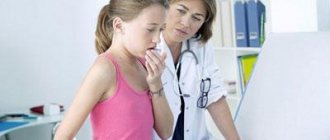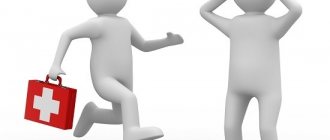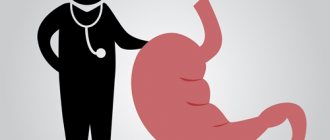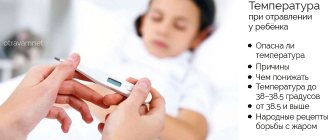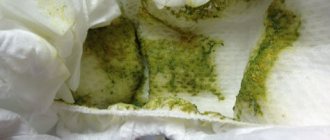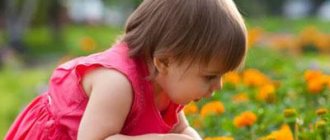If parents have a suspicion that the child has been poisoned, i.e. symptoms and signs indicate poisoning, and not an exacerbation, for example, of a chronic disease; you should not delay the start of therapy.
The beginning of treatment is always the most difficult, since the child feels unwell and will most likely refuse everything, including much-needed water. In the article we will tell you how you can get your baby drunk, and also list the actions that you should not do if you are poisoned.
How to treat
The first step in treating food poisoning in children is eliminating the toxin from the gastrointestinal tract . Lavage allows you to clear the stomach of toxic agents and undigested food residues. The most effective procedure will be in the first hours after signs of poisoning appear in a child. Taking enterosorbents and intestinal antiseptics will help remove the toxin that has entered the intestines.
Food poisoning is always accompanied by repeated vomiting and diarrhea . In children, especially in the first years of life, dehydration quickly occurs in such conditions. Massive loss of fluid and electrolytes leads to metabolic disorders and malfunctions of the cardiovascular system. In severe cases, dehydration can lead to death. Oral rehydration solutions can help replenish fluid and mineral loss at home. It is necessary to frequent and frequent drinks to compensate for losses.
Carefully! Not every vomiting or diarrhea will be accompanied by dehydration. But if the baby does not answer you or responds inadequately and/or is literally writhing in pain, calling an ambulance is necessary.
After eliminating the toxin and normalizing the water-electrolyte balance, it is necessary to relieve the symptoms accompanying food poisoning . An increase in body temperature to 38.5 or higher requires the prescription of antipyretics.
A mandatory part of the treatment of food poisoning in children is diet . Food should contain all the necessary nutrients and at the same time be gentle on the gastrointestinal tract.
Important! All foods that cause fermentation, increase peristalsis, or irritate the intestines are excluded from the diet.
What not to do
Restrictions for food poisoning:
- don't stop the diarrhea . Antidiarrheal drugs do not cure diarrhea; they temporarily stop intestinal motility. Thus, the toxin remains in the digestive tract and is absorbed into the blood. These drugs are prohibited for use in children under 12 years of age , because they can have opiate-like effects if taken incorrectly;
- don't give enzymes . Often, when poisoning occurs, gastric motility is disrupted and fermentation processes of undigested food begin in it. It will not be possible to “push” food through with the help of enzyme preparations - this will aggravate the condition. It will be more effective to get rid of the stomach contents by thorough lavage;
- Don’t “mask” the pain . Symptoms of poisoning are similar to the first signs of inflammatory diseases of the gastrointestinal tract. And pain relief in this case will make it difficult to make a correct diagnosis. Antispasmodics (drotaverine, papaverine) relax the smooth muscles of the intestine. This makes it difficult for gases to enter, which increases abdominal discomfort.
Prevention
To avoid poisoning, buy products only from trusted places, carefully examine the integrity of the packaging, expiration dates, and pay attention to storage conditions.
Basic preventive measures:
- Teach your child to wash his hands frequently and thoroughly from an early age, especially after a walk, going to the toilet, and before eating.
- Do not give your baby any food outside.
- Wash fruits and vegetables thoroughly, if possible soak in hot water, especially those that come into contact with the soil.
- Do not feed your children sushi or bloody meat.
- If you leave food on the table, be sure to cover it.
- Flies and cockroaches are carriers of infection, so they must be fought mercilessly.
Do not buy anything from the grocery store, and during hot weather, refrain from purchasing desserts with cream. In summer, it is better to minimize the consumption of milk and eggs; do not feed children mushrooms, especially wild mushrooms.
First aid
Before you step-by-step analyze the algorithm of action in case of poisoning in a child, you should indicate cases in which treatment at home is prohibited.
So, hospitalization is necessary if (if):
- the child is under three years old;
- development of symptoms of poisoning after eating mushrooms;
- the presence of blood in the form of streaks in vomit and feces;
- indomitable vomiting, making it difficult to drink;
- increasing symptoms of dehydration (pallor and dryness of the skin and mucous membranes, decreased amount of urine, increased heart rate, shortness of breath, impaired consciousness);
- changes in the skin (yellowness, rash);
- the presence of symptoms of poisoning in several family members;
- development of signs of botulism: double vision, impaired speech and swallowing, convulsions.
If a child experiences nausea, vomiting, diarrhea and abdominal pain, parents should follow the following action plan :
- Gastric lavage with a 2% solution of baking soda (half a teaspoon of sodium bicarbonate per 100 ml of water). The volume of liquid drunk should be 50-100 ml/kg for children under one year of age, and 0.5 liters per year of age for children over one year of age (but not more than 7 liters). The solution temperature should be 36-37°. The stomach should be rinsed repeatedly until the rinsing water is clean.
- Elimination of toxin . Taking enterosorbents: activated carbon, Enterosgel, Smecta. The intestinal antiseptic Nifuroxazide can be used in the form of a suspension and tablets (carefully look at the age restrictions).
- Rehydration . The optimal means for feeding a child are oral rehydration solutions (Regidron, Humana Electrolyte, Gastrolit, ORS). If a child refuses to drink pharmaceutical products, you can offer him regular bottled water without carbon or a compote of dried fruits. Do not use packaged juices , sweet carbonated water or dairy drinks for rehydration. You need to drink often, but in small portions (1-2 sips).
- Diet . In children under one year of age, the optimal diet for poisoning is breast milk or adapted fermented milk formulas. Older children can be given buckwheat or rice porridge with water, bananas, baked apples, biscuits, and ground lean meat.
Causes
There are many factors contributing to intoxication processes. These can be toxic substances, medications, waste products of pathogenic microbes and even opportunistic bacteria. Acute poisoning is caused by different groups of substances, the main ones are:
- Carbon monoxide.
- Medications.
- Mushrooms.
- Substances containing alcohol, including surrogates.
- Liquids that have a cauterizing effect.
Intoxication involves poisoning from stale foods contaminated with pathogenic microorganisms, various chemicals, and salts of heavy metals.
Acute microbial infections that affect various organs and systems are also accompanied by intoxication phenomena. Certain signs of intoxication can provoke:
- Helminthiases.
- Diseases of the hepatobiliary system and kidneys.
- Oncological diseases.
- ENT pathologies (tonsillitis, adenoiditis, acute respiratory infections).
- Dental diseases (dental caries).
- Rheumatism in latent form and many others.
In children, quite often the first manifestation of a sore throat or flu is a gastrointestinal disorder. But most often the intoxication process accompanies ordinary food poisoning and intestinal infections caused by opportunistic microflora. As children grow their teeth, they actively insert their fingers (often dirty) into their mouths and chew on contaminated toys. Thus, bacteria enter their body, causing abdominal symptoms.
Intoxication caused by salmonella and staphylococcus is dangerous for young children. It is these poisonings that most often occur in young patients. Salmonellosis in children can be fatal. Therefore, proper processing and storage of both products and semi-finished products, as well as ready-made dishes, are very important.
There is so-called tuberculosis intoxication. It accompanies the first contact of the body with Mycobacterium tuberculosis, and there are no pronounced tuberculosis foci. More common in children.
What to give: selecting a medicine
The main groups of drugs for the treatment of food poisoning are:
- enterosorbents,
- antimicrobial drugs,
- oral rehydration solutions.
Activated carbon and other drugs
Effectively adsorbs various toxic substances from the gastrointestinal tract without irritating the mucous membrane. It should be used at the rate of 1 g per kg of the child’s weight.
Enterosgel
It is a “molecular sponge” that binds toxins from the digestive tract. It is not absorbed from the gastrointestinal tract, does not irritate its walls and does not affect peristalsis.
Dosages:
- children under one year : ½ teaspoon 6 times a day (pre-dilute with water or breast milk);
- from 1 year to 5 years : ½ tablespoon 3 times a day;
- over 5 years : 1 tablespoon 3 times a day.
Smecta
Natural aluminosilicate with a pronounced adsorbing effect. It is not absorbed and does not affect gastrointestinal motility . Children under one year old are prescribed 2 sachets per day, over one year old - 4 sachets per day. Before use, Smecta is dissolved in a baby food bottle (50 ml) and given in small portions throughout the day.
Oral rehydration solutions
Available in the form of powders or granules that require dilution with water. They contain electrolytes (sodium, potassium, chlorine), as well as glucose and plant extracts in properly selected ratios. The main disadvantage of pharmaceutical solutions is the unpleasant taste, which can complicate the child’s desolation .
Antibiotics
When treating food poisoning in children at home, you should refrain from taking systemic antibacterial drugs. This is due to the impossibility of accurately determining the pathogenic microorganism that caused the poisoning.
A relatively safe antimicrobial drug for the treatment of food poisoning is Nifuroxazide . This is a broad-spectrum intestinal antiseptic that is practically not absorbed from the gastrointestinal tract. For children under 6 years old, a suspension is indicated (5 ml 3 times a day), over 6 years old - in tablet form (2 tablets, 4 times a day).
The use of enemas for food poisoning
Sometimes, it becomes necessary to rinse not only the stomach, but also the intestines in order to get rid of the toxins located there. To do this, you can resort to an enema.
The essence of an enema is that a special solution is injected into the intestines using a special device. This solution lingers in the body for a short time, and then, leaving it, washes away all the decay products inside. In order to give an enema to children, you need to seek the help of a person experienced in these matters, as damage can be caused.
To properly administer an enema, you need to follow a certain algorithm:
- A rubber bulb of suitable size (check with the pharmacy) must be boiled in clean water for half an hour for disinfection.
- Hands should be washed thoroughly; you can wear medical gloves.
- The child is placed in the correct position, if it is a newborn, then on his back, having first placed a diaper or diaper under him. If we are talking about an adult child, then he should lie on his side, pulling his legs to his chest.
- You need to fill the pear with warm, clean water or a prepared solution.
- The enema tip must be lubricated with special Vaseline.
- Having pulled the baby's legs towards the stomach, you need to carefully insert the tip into the anus 3-4 cm. First, you need to release the air from the bulb by pressing on it. As for adult children, the procedure is carried out in the same way, only they bent their legs on their own.
- The contents of the enema should be administered while the child inhales, slowly pressing it.
It is necessary for the child to be patient and then go to the toilet or potty. If we are talking about a baby, then you need to squeeze the buttocks so that the liquid does not come out immediately, since he does not yet know how to endure it on his own.
If the emptying went well, the procedure is repeated. After this, the child is washed and dressed in clean linen.
At home
Treatment of poisoning in a child at home is possible only in cases where parents can fully control the situation and prevent the development of complications . Children under 3 years of age require compulsory medical care for poisoning. This is due to the fact that it is difficult for them to properly rinse their stomach and give the necessary medications. In this case, dehydration and general intoxication occurs very quickly.
Treatment of poisoning in children at home should be carried out in stages and after consultation with a pediatrician, in compliance with the regimen prescribed by the doctor. All medications must be used according to instructions. At the first sign of complications, self-treatment should be stopped.
State Definition
Intoxication is usually called a disruption of the vital functions of a living organism due to the entry of endo- or exotoxins into the tissues. The term is used in medicine and pharmacological practice.
Intoxication can be:
- Super acute.
- Spicy.
- Sub-acute.
- Chronic.
Hyperacute intoxication is lethal without assistance. The death of the patient occurs within a few hours. Its characteristic feature is damage to the central nervous system - convulsions, incoordination. The acute form is accompanied by severe symptoms. It develops as a result of a single and short-term exposure to the toxin. Subacute has a less pronounced clinical picture than the previous one and occurs as a result of several repeated episodes of poisoning. The chronic course of the process is mildly symptomatic. Occurs under the influence of repeated or constant exposure to toxins.
Summary for parents
Any digestive disorder in a child is not a trifle. If symptoms of food poisoning appear, you should seek medical help immediately. You should not try to treat children yourself. Incorrect treatment can lead to irreparable consequences. The main task of parents is to be able to recognize the manifestations of poisoning and consult a doctor in time. This is the key to successful treatment. Compliance with simple but universal preventive rules that do not require special costs is the only way to protect children from poisoning.
The “Doctor Komarovsky School” program tells how to help a child with food poisoning:
Diagnosis and treatment
For any signs of poisoning, doctors prescribe blood and urine tests. If an intestinal infection is suspected, an infectious disease specialist will provide advice. Stool samples are examined to identify pathogenic and opportunistic flora.
If tuberculosis intoxication is suspected, the patient is examined by a TB specialist and a pulmonologist, an X-ray of the lungs is prescribed, and tuberculin tests are performed. Other tests may be recommended. For example, a nasopharyngeal swab for signs of sore throat.
Symptoms and treatment of intoxication depend on the toxin that led to the disorder. At the first stage of helping a small patient, they try to speed up the removal of harmful substances from the body as much as possible. For food poisoning, treatment begins:
- With gastric lavage (sometimes multiple times).
- Introduction of enterosorbents (Filtrum).
- Administration of saline or glucose-saline solutions to maintain electrolyte balance.
Etiotropic therapy depends on the microorganism that caused the described syndrome. These are usually broad-spectrum antibiotics. In the case of tuberculosis intoxication, specific treatment should be combined with desensitization and the intake of vitamin complexes.
If intoxication of the body is caused by ENT pathology or respiratory infections, the main method to alleviate the child’s condition is to drink plenty of vitamins. With all other possible options, treatment is carried out with an emphasis on the cause of the disease. In some cases, symptomatic therapy is prescribed. For example, Cerucal or its analogues are administered to combat nausea.
Routes of penetration of toxins
Exogenous toxic substances can enter the body of a child and an adult:
- Through the skin.
- When inhaling toxic and aggressive substances.
Depending on the route of penetration, specific symptoms may appear, for example, skin itching, erythema, blisters and other skin reactions when the toxin gets into the surface tissue. When toxic irritants are inhaled, children and adults exhibit respiratory symptoms (coughing, wheezing, bronchospasm).


